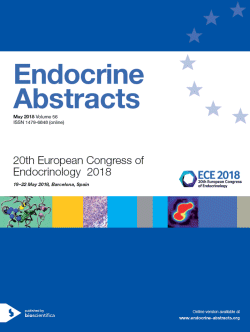
20th European Congress of Endocrinology
Barcelona,
Spain
19 May 2018 - 22 May 2018
Guided Posters
Obesity
ea0056gp149 | Obesity | ECE2018
Sex hormone-binding globulin is more than a sex steroid carrier: a New therapeutic target against obesity and non-alcoholic fatty liver disease
Saez-Lopez Cristina , Hernandez Cristina , Simo Rafael , Selva David M
ea0056gp150 | Obesity | ECE2018
Use of ultrasonography as a simple diagnostic method to measure different abdominal fat layers and metabolic syndromeprediction
Cuatrecasas Guillem , De Cabo Francisco , Patrascioiu Ioana , Coves Maria Jose , Cuatrecasas Gabriel , Aranda Gloria , Aguilar-Soler Gerardo , March Sonia , Calbo Marta , Bretxa Clara , Balfego Mariona
ea0056gp151 | Obesity | ECE2018
Improvement in insulin-mediated suppression of branched-chain amino acid flux is responsible for the post-bariatric surgery decrease in plasma branched-chain amino acid levels
Yao Jie , Kovalik Jean-Paul , Tham Kwang Wei , Bee Yong Mong , Lee Phong Ching , Eng Alvin , Chan Weng Hoong , Lim Eugene , Lim Jeremy , Tan Hong Chang
ea0056gp152 | Obesity | ECE2018
Cell-derived extracellular vesicles as important intercellular messengers in obesity
Witczak Justyna , Datta Dev , James Philip , Rees Aled
ea0056gp153 | Obesity | ECE2018
How to better predict weight loss and type 2 diabetes remission after bariatric surgery? the potential role of genetic scoring systems in clinical practice
Lecube Albert , Simo Rafael , Ciudin Andreea , Pich Sara , Vilarrasa Nuria , Caixas Assumpta , Sanchez Enric , Simo Andreu , Gutierrez Liliana , Salas Eduardo , Ortega Israel , Guillen Kevin , Casagran Oriol , Rigla Mercedes , Baena Juan Antonio , Fort Jose Manuel , Luna Alexis , Rebasa Pere , Balibrea Jose Maria , Fidilio Enzamaria , Bueno Marta , Pareja Rocio , Hurtado Marta , Ortiz Angel , Hernandez Cristina
ea0056gp154 | Obesity | ECE2018
Eating and substance-related disorders after bariatric surgery
Sanz Eva , Kinori Guila-Fidel , Parramon Gemma , Fidilio Enzamaria , Velasquez Mayra-Alejandra , Guerrero Mireia , Comas Marta , Mesa Jordi , Ciudin Andreea
ea0056gp155 | Obesity | ECE2018
Changes in gut microbiota and metabolic profiles after sleeve gastrectomy
Puig Rocio , Pellitero Silvia , Martinez Eva , Tarasco Jordi , Moreno Pau , Vilarrasa Nuria , Vendrell Joan , Fernandez Sonia , Puig-Domingo Manel
ea0056gp156 | Obesity | ECE2018
Pharmacological stimulation of p53 with low-dose doxorubicin ameliorates diet-induced nonalcoholic steatosis and steatohepatitis
Rellan Maria Jesus Gonzalez , Couto Begona Porteiro , Fondevila Marcos Fernandez , Buque Xabier , Fernandez Uxia , Mora Alfonso , Beiroa Daniel , Lopez Miguel , Sabioc Guadalupe , Dieguez Carlos , Aspichueta Patricia , Nogueiras Ruben
ea0056gp157 | Obesity | ECE2018
Obesity is associated with a dysregulation in the splicing machinery components at the hepatic level: influence of metformin
L-Lopez Fernando , Alors-Perez Emilia , del Rio-Moreno Mercedes , Sarmento-Cabral Andre , Castano Justo P , Luque Raul M , Gahete Manuel D
ea0056gp158 | Obesity | ECE2018
Dietary intake of fat and oil are associated with expression of miR-143 and miR-34a in visceral and subcutaneous adipose tissues of adults: a nutriepigenetic study
Yuzbashian Emad , Asghari Golaleh , Zarkesh Maryam , Zadeh-Vakili Azita , Mirmiran Parvin , Hedayati Mehdi , Khalaj Alireza
ea0056gp159 | Obesity | ECE2018
Role of Elovl6 in the thermogenic action of brown and beige adipocyte during β3-adrenergic receptor activation
Sharma Rahul , Matsuzaka Takashi , Motomura Kaori , Hui Zao , Ohno Hiroshi , Takeuchi Yoshinori , Yahagi Naoya , Sekiya Motohiro , Nakagawa Yoshimi , Muratani Masafumi , Shimano Hitoshi
ea0056gp160 | Obesity | ECE2018
Physiological regulation of brown adipose tissue in obesity by mild-cold exposure, a B3-agonist and exercise training at thermoneutrality
Aldiss Peter , Lewis Jo , Ebling Fran , Budge Helen , Symonds Michael
ea0056gp161 | Obesity | ECE2018
Cold induced thermogenesis is influenced by seasonal changes in outdoor temperature
Senn Jael Rut , Maushart Claudia Irene , Gashi Gani , Becker Anton S , Muller Julian , Burger Irene A , Betz Matthias Johannes



